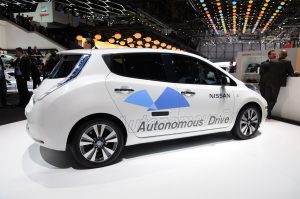 The next few decades are going to see major changes in personal transportation, including product design geared toward increased safety, the reduction of vehicle-related emissions and ‘new’ energy sources.
The next few decades are going to see major changes in personal transportation, including product design geared toward increased safety, the reduction of vehicle-related emissions and ‘new’ energy sources.
This will be the biggest industrial shift since the automobile’s inception, when horseless carriages began replacing buggies and buckboards pulled by beasts of burden as a better way to get people and goods from point A to point B. And the various impacts on jobs, pollution and climate change, the economy and America’s still-strong love affair with cars are yet to be determined.
But let’s consider the width and breadth of what’s on the horizon. Including how Attesa will participate in the revolution.
Autonomous vehicles are coming. It’ll be at least a decade before we know to what extent computer-controlled cars, trucks and buses might carve their place into American cities, town and highways. But make no mistake. They’re on their way and there’s no turning back.
The main reason is safety.
NOTE: The Attesa team recently attended the Smart City Summit sponsored by the Arizona Technology Council. During the Transportation seminar, featuring executives from Uber, Lyft and Veyo — who are all testing and gathering data for autonomous vehicle adaptation — plus the Director of the Transportation Research Institute at the University of Arizona, we learned some sobering facts about traffic deaths.
94% of all traffic fatalities are due to accidents caused by driver error. Since the end of the Viet Nam war, more military personnel have been killed on streets and highways than on the battlefield. More first responders lose their lives on the way to the emergency than while answering their chosen call of duty. Because humans behind the wheel make mistakes.
Autonomous smart vehicles, always in touch with smart cities, satellite communications and a constantly-getting-smarter cloud, could save 1.2 million lives per year due to a massive reduction in traffic accidents. They make far, far fewer mistakes than mom, dad, junior and grandpa.
As self-driving cars take over, personal vehicle ownership will decrease, insurance costs will go down and due to less fossil fuel being burned, vehicle emissions could be reduced by as much as 90%. But the main and noble reason our government is supporting carmakers in their fast-track development of these new technologies is to save lives.
Projecting emissions reduction is always iffy. There are many factors that influence energy production and the overall level of greenhouse gases created and measured at either the vehicle’s tailpipe or the utility company’s smokestacks.
Germany, Norway, Scotland, France, India and China have announced plans or set deadlines for banning gasoline and/or diesel fuel -powered vehicles. They’re not messing around.
Volvo was the first major ICE manufacturer to commit to an all-electric product line but now Ford and General Motors have pledged that fraternity, joining smaller companies like Tesla, Lucid Motors and others. Mazda and Toyota recently announced they are creating a new car company to develop electric vehicles. Honda is produced an electric car just for China.
Battery charging will increase energy demand from local utilities, producing more emissions from powerplants. Grids and home electrical systems will require major upgrades. New and more waste, including everything from more spent nuclear rods and coal ash to environment and health -hazardous byproducts from the production of lithium-ion batteries will have to be disposed of safely.
Then there’s the potential of hydrogen as the most common and efficient vehicle fuel of the future.
There are two basic approaches to using hydrogen to produce usable power: the proton exchange membrane (PEM, also called polymer electrolyte membrane) fuel cell and the classic internal combustion engine (ICE).
PEM fuel cells use hydrogen fuel and oxygen from the air to produce electricity. The process creates H20 instead of CO2 as the emissions byproduct.
Hydrogen can be produced as a liquid or gas from diverse resources including biomass, fossil fuels and water electrolysis with electricity. The environmental impact and energy efficiency of hydrogen depends on how it is produced. But there’s no free lunch. Other than sunshine, wind and water flow (so far), it takes energy to make energy.
BMW, Ford and Mazda have experimented with both PEM fuel cells and hydrogen-burning internal combustion engines. The rationale for researching hydrogen as fuel for ICE’s is lower upfront costs due to the large supply of existing powerplants. Conversions are comparatively simple, mainly new fuel injectors, software programming and a storage system..
But before hydrogen-powered engines or PEM fuel cells make a significant impact, an expensive, ambitious, publicly-accessible distribution network needs to be built. And like when electricity replaced gas which replaced oil lamps, and like how jets replaced prop aircraft and wireless communications replaced land lines, fueling infrastructures – for both EV’s and hydrogen-powered cars — will eventually be created, all over the globe.
Some may be skeptical, intimidated or even afraid of all this change. Others are excited. Like the team developing Attesa.
Our 2,519-acre community is being built to facilitate the necessary research and development that will be part and parcel of the changeover. We’ll offer industrial, garage and light manufacturing space, preferred access to a 2.8-mile test circuit and the benefits of educational partnerships to promote thought leadership, training and a necessary workforce.
 And regardless of the introduction and subsequent market growth of electric and autonomous vehicles, there will always be high-performance vehicles licensed for the street but engineered for the track. With advanced technology, highly efficient internal combustion engines that make beautiful sounds and extravagant horsepower.
And regardless of the introduction and subsequent market growth of electric and autonomous vehicles, there will always be high-performance vehicles licensed for the street but engineered for the track. With advanced technology, highly efficient internal combustion engines that make beautiful sounds and extravagant horsepower.
Some believe that eventually, private race tracks will be the only place these fast, relatively exotic, handle-like-they’re-on-rails cars and motorcycles, piloted by passionate enthusiasts, will be allowed to stretch their legs.
We’re going to have just such a circuit, with use and competition event privileges included with membership in a private club featuring a driver’s lounge and clubhouse, access to our private air strip and exclusive purchase options for our luxury trackside ‘Garage Majals’ zoned for residential occupancy.
Attesa is enthusiastic and optimistic about the shape of things to come. We’re building a mini-city dedicated to vehicle engineering, high performance driving and motorsports; a destination community that will bridge what was before and what will be in transportation design, smart technology and racing entertainment.
